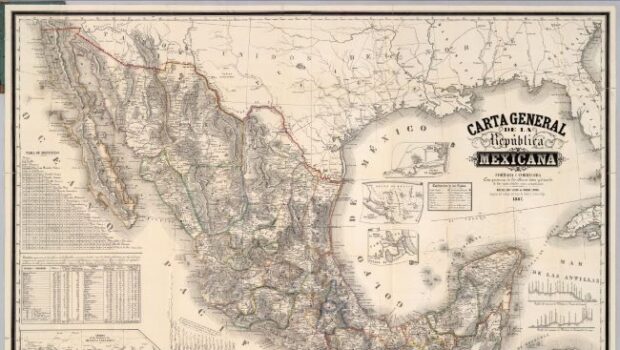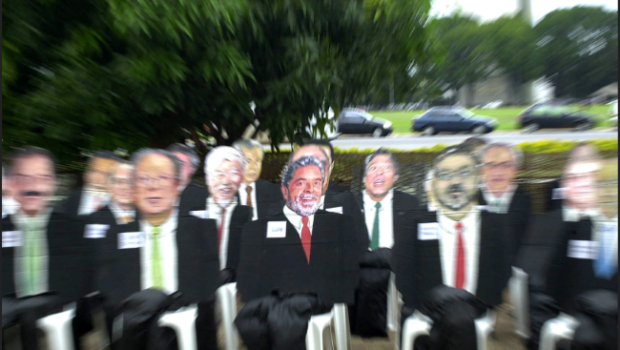Three Forms of Mexican Fiction
Martín Solares
English translation by Tanya Huntington
They are not made from the same stuff as lies, although they do employ some of the same themes, characters and resources. Nor are they cut from the same cloth as the truth, despite their intent to be similarly plausible and incandescent. The fictions being fabricated in Mexico are of a different sort, and yet they are competitive both in terms of range and form: at best, they arise from the urge to critique reality; at worst, the urge to supplant it with something even ghastlier.
Those of us who have lived in Mexico over the past seven years have seen a wide variety of fictions emerge in daily life, many of them destined to either kill or be killed. As the country came to realize that, during President Calderón’s six-year administration, politicians were using the word “justice” less and less frequently–until it had become quite unusual to hear any public official promise that the law would be upheld to its full extent–we were also horrified to learn that our country boasted a police force that would rarely if ever enter into conflict with these delinquents, due to the fact that it was collaborating with, protecting, or taking orders from some of the region’s dominant criminal organizations. If one happened to live near our northern border, so far from human rights and so close to the United States, it was not odd to hear of armed groups running about town, picking up or kidnapping people, instigating firefights and, when things calmed down, making highly successful incursions into extraordinary entrepreneurial niches, such as the sale of pirated music and films; the extortion of restaurants, hotels and small businesses; or the obligatory sale of adulterated alcohol to bar owners; not to mention backing certain politicians’ campaigns, or the cowardly sex trafficking of women.
Herein the paradox: the more outlandish these fictions became, the greater the determination to protect them at any cost. First and foremost, we have the fiction that sustains that in this country, an oasis of calm prevails. Jealously doing their duty, governors of states like Puebla or Veracruz have preferred to harass journalists rather than provide the minimal security conditions required to do their jobs. And one does not even consider investigating the aggressions they have suffered: rather, one kidnaps those who denounce the exploitation of women (which is what happened to Lydia Cacho). Then there’s the attempt to avoid having any newspaper describe the climate of violence that is being experienced, day in, day out, in Tamaulipas, where three of our past governors are under investigation or have orders of apprehension from the DEA. Spearheading this trend, the governor of Veracruz went so far as to pass a law that prosecutes any who dare to circulate via Twitter unproven facts or rumors that, in his administration’s opinion, disturb the reining fiction of tranquility; let’s not scare away the tourists, those capricious souls. It should come as no surprise that most citizens wind up accepting, through cynicism, resignation, or frank and generalized depression, that if they are to even consider living in this country’s most unfortunate cities, they will have to build up a tolerance for shootouts, disappearances, mini-kidnappings and other forms of disdain for human life.
Among the worst traditions in Mexican politics is one that allows the president du jour to establish, during his mandate, the fiction under which he wants us all to live. This mirage is backed up by journalists and newscasters, endorsed by his followers and the ingenuity of well-meaning citizens, but it is not a fiction that will manage to survive. As soon as one president leaves, the next throws himself into refuting the depiction under which the country lived for so long –with a little help from reality. Thanks to these fictions, which are idiotic, but backed in full by public spending, it is not uncommon to hear from leaders who dodge their responsibility for disasters that have taken place in recent history while at the same time insisting that the executions of defenseless people in sleepy churches, family gatherings, hospitals, or funerals were merely understandable examples of scores being settled between members of that despicable specimen, the impious drug trafficker, who does not deserve to have his murder investigated or his murderers punished…
The next sign of alarm, the next omen that the practice of fiction has suffered a decline in Mexico, is represented by the narcomantas. These strange, ephemeral tales, generally banners featuring misspelled words draped over the cadaver of a rival, are evidence that the same criminal organizations that have operated in a clandestine fashion for decades have decided to influence public opinion: the traffickers have elected to come out of the shadows (relatively speaking, because they wouldn’t want the DEA to arrest them) in order to broadcast their ideas, principles and convictions. They have attempted to convince us that in some states, Michoacán for example, there are also good crooks (those that call themselves “The Family” or, hold on to your hats, “The Templar Knights”), and that if they do carry high-caliber weapons, it is only to help them steal from the bad crooks (be they the Zetas, the New Generation Jalisco Cartel, or the enemy of the week) in order to protect poor little society –you can see how sorely it has been neglected by the government, that great oaf. What these banners fail to mention is exactly what their authors are capable of doing to any citizen who finds it hard to believe in their pure intentions.
Besides suggesting complicity between the government and rival groups whenever it is convenient to do so, besides washing their hands of a cowardly attack, such as launching several grenades into a crowd that was celebrating Independence Day on September 15 in Morelia in 2008, the narcomantas have also sought to set the populace at ease. Whenever rumors spread that a new firefight is about to be unleashed in cities like Tampico, Nuevo Laredo, Matamoros or Reynosa, the first ones to react in order to avoid collective psychosis and the corresponding attention from the international media have not always been the politicians of the state of Tamaulipas in their attempts to dismiss the slander, but criminal organizations, including the Gulf Cartel: after all, who wants rumors to be flying around after a score is settled, or worse yet, who wants those news stories to start spreading? But, and this is something both politicians and criminals ought to know, fictions are not made by decree. In the case of the pacifist narcomantas, the same old spelling mistakes turn worrisome. Because if the authors of said messages are so terribly careless in drafting them, what is to assure us that they won’t cause any collateral damage while settling one of those scores propagated by bad faith?
The passion of the drug traffickers for writing fictions is also manifested in other ways. It is said that along Mexico’s northern border, every time some local boss takes an interest in transmitting his conviction that the city where he does business is a peaceful place –one that is not crying out for the intervention of the army or the Red Cross– he coerces journalists from the zone to avoid publishing information about the umpteenth spate of mass executions, or the body count from battles between opposing gangs, through strategies that range from bribery to intimidation –not to mention the more simple and direct armed attack on a newspaper’s editorial room. Thus, while politicians suggest to journalists what words to write, the criminals are there to tell them when to shut up. Caught between the catch phrases suggested by politicians and the silence demanded by drug traffickers, exactly how free is the speech of Mexican reporters today? And what has Mexican fiction done about it? Has it acted as an accomplice to both government and criminals, determined to circulate the official story? Or worse yet, has it turned spineless, failing to examine the society from whence it comes? Does it, out of cowardice, also form part of the conspiracy?
One look at our literature is enough to show that throughout the 20th century, Mexican narrative took it upon itself to obsessively reflect on the Revolution of 1910. From Pedro Páramo, by Juan Rulto, to Porque parece mentira la verdad nunca se sabe, by Daniel Sada, there are a dozen stupendous novels denouncing the Mexican political class. The repression of guerrillas and the student movement of ’68 also generated some masterful testimonies and have appeared in countless recent novels, but there are few, very few, almost exceptional fictions that dare to associate politics with drug trafficking. While drug lords and judicial police have started to appear in the short stories of Francisco Hinojosa, Enrique Serna and Eduardo Antonio Parra, or in the novels of Héctor Manjarrez, Paco Ignacio Taibo II, Leonardo da Jandra, Leónidas Alfaro, Luis Humberto Crostwaithe and Juan José Rodríguez, the first masterpiece to approach the last great crime of the 20th century is Contrabando, by Víctor Hugo Rascón Banda. Contrabando is one of the most moving novels to have touched upon this theme. Parting from the misfortunes and aspirations of the inhabitants of a town lost in the Chihuahua sierra, it already insinuated in 1991 the sizable percentage of Mexican society that depends on or dreams of depending on money that comes from drug trafficking.
Contrabando remained unpublished until 2008, despite having won the Juan Rulfo Prize. Which is why Élmer Mendoza became, in 1999, the first narrator to publish a novel that takes on the theme of drug trafficking using literary motifs. With Un asesino solitario, Mendoza embarked on a fortunate career distinguished by the creation of a series of captivating characters whose common denominator is their desire to survive all the violence –it was no accident that Arturo Pérez Reverte himself hired Mendoza as a consultant while researching La reina del sur. In a literary tradition that has provided many novels, but few memorable figures, Élmer Mendoza stands out thanks to his talent for creating three-dimensional fictional beings, from the hitman Yorch Macías to the judicial police officers who accompany him; not to mention his penchant for crafting flawless tales that stem from the stream of consciousness of these imaginary beings. Convinced that in literary fiction, not all should remain clear, in Mendoza’s novels there are paragraphs by day and paragraphs by night, chapters where details are provided with crystal clarity and others that are submerged in a deliberate darkness in order to better express certain emotions. Aware that in order to tell the tale of an individual who risks his own life, a narrative can become exalted, diffuse, repetitive or sinuous, and that not everything should be orderly and linear, novels like El amante de Janis Joplin or Cóbraselo caro create a rhythm that recalls contemporary corridos, in a similar vein as the musicians of Los Tigres del Norte.
From 1999 to date, the violence that was once sporadic became an everyday occurrence. In an attempt to bring about the censorship of communications media, the administration of President Enrique Peña Nieto asked reporters to apply a “new narrative” to the violence whose methods and scope have yet to be analyzed. Meanwhile, on the cutting edge of this new censorship, it’s no wonder that a new wave of writers have chosen to make criminals the protagonists of their stories, in an attempt to understand the direction being taken by one of the most complex (and corrupt) societies of Latin America. Whether by showcasing the lover of a drug lord, as Orfa did in Perra brava; or by adopting the language being spoken in Mexico and making it crawl like one of those mollusks that select and assimilate foreign objects as they go along in order to create a majestic form, as Yuri Herrera did in Los trabajos del reino or in his masterful La transmigración de los cuerpos; whether by taking on with a critical capacity that is seldom seen the hypocrisy of Mexican society regarding the misfortune of others, like Antonio Ortuño did in La fila india, one of the pinnacles of corrosive prose in our country; or by situating endearing and atypical stories within zones of conflict, like Londres después de media noche and Fiesta en la madriguera by Juan Pablo Villalobos, or like La marrana negra de la literatura rosa and La Biblia vaquera by Carlos Velázquez; new literary fiction, Mexican style, refuses to turn its back on violent events.
In the end, the literary fictions being written in Mexico are not so different from those that have been written in other countries during dark times. They take on the same challenge any author meets: choosing a piece of reality and trying to make something lasting out of it. Even if that reality burns some fingers in the process, the voice of an author still must try and have something to say to readers in a century’s time. On one hand, we have lies and rumors in the dark, a terrible tide that breaks with increasing force; off in the distance, we have the scientific truth being upheld by the historian or journalist who can scarcely manage to illuminate the blackness of night with their filaments of truth. And alongside them, we have those who write literary fiction.
In everyday life, the common mortal has only one choice: to advance step by step, eyes open, perceiving the world with varying degrees of clarity or despair; which is how we live at present. But those who write or read novels have something more: an opportunity to open up as many doors of perception as there are verbal tenses, to go forth and multiply via those vehicles known as characters and thereby, to live other lives, to cross over into other worlds and enrich the notion we sustain of both present and past. Thus, novels whisper to us that we live on different planets at the same time: what was, what will be, what is, what could be, what we hope would be. Expanding readers’ lives or suggesting how many dimensions they encompass is one of the great contributions of the novel, one that, somehow, allows us to recover our faith in the extraordinary and doubtless, one of the vast powers wielded by those who practice Mexican fiction.
Posted: August 25, 2014 at 10:08 pm










